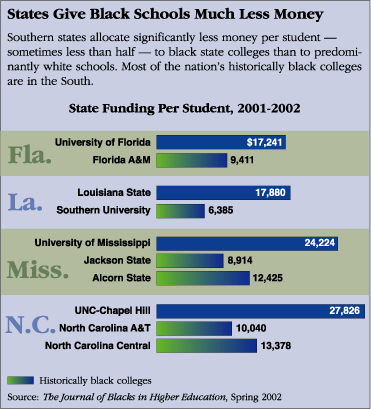
TGIF POU!
Today we continue our topic of education equality with a look at the legacy of disparity in funding for Historically Black Colleges and Universities (HBCUs).
Before the end of the Civil war, the Morrill Land-Grant Colleges Act (Morrill Act of 1862) was passed to provide for federal funding of higher education by each state with the details left to the state legislatures. Following the war, the 14th Amendment to the United States Constitution guaranteed equal protection under the law to all citizens, and Congress established the Freedmen’s Bureau to assist the integration of former slaves into Southern society. After the end of Reconstruction in 1877, former slave-holding states enacted various laws to undermine the equal treatment of African Americans, although the 14th Amendment as well as federal Civil Rights laws enacted during reconstruction were meant to guarantee it. However Southern states contended that the requirement of equality could be met in a manner that kept the races separate. Furthermore, the state and federal courts tended to reject the pleas by African Americans that their 14th Amendment rights were violated, arguing that the 14th Amendment applied only to federal, not state, citizenship.
After the end of Reconstruction, the federal government adopted a general policy of leaving racial segregation up to the individual states. One example of this policy was the second Morrill Act (Morrill Act of 1890), which implicitly accepted the legal concept of separate but equal for the 17 states which had institutionalized segregation:
Provided: That no money shall be paid out under this act to any State or Territory for the support and maintenance of a college where a distinction of race or color is made in the admission of students, but the establishment and maintenance of such colleges separately for white and colored students shall be held to be a compliance with the provisions of this act if the funds received in such State or Territory be equitably divided as hereinafter set forth.
Prior to the Second Morrill Act, 17 states excluded blacks from access to the land grant colleges without providing similar educational opportunities. In response to the Second Morrill Act, 17 states established separate land grant colleges for blacks that are now referred to as public historically black colleges (HBCUs). In fact, some states adopted laws prohibiting schools from educating blacks and whites together, even if a school was willing to do so. (The Constitutionality of such laws was upheld in Berea College v. Kentucky, 211 U.S. 45 (1908).) Under the ‘separate but equal doctrine’, blacks were entitled to receive the same public services and accommodations such as schools, bathrooms, and water fountains, but states were allowed to maintain different facilities for the two groups.
Southern States and those states where HBCUs were located, willfully ignored federal statute. Facilities and resources were neglected and African Americans forced to subside on bare basics in providing higher education for their children. Indeed, without a commitment to provide such to its brightest students, who would teach, train and lift a generation removed from slavery, from the sharecropper’s fields?
Again, African Americans used the court system to challenge the discrepancies in funding and resources towards their education.
The Thurgood Marshall School of Law (TMSL) was created as a consequence of a 1946 lawsuit brought by Heman M. Sweatt (Sweatt v. Painter). Under the Texas Constitution, which required separate but equal treatment, Sweatt was refused admission to the University of Texas School of Law because he was black. As a result, the legislature provided for an interim and separate law school for Negroes. During its first academic year, the law school was housed in Austin, TX, and was subsequently transferred to the new university campus in Houston. The ruling in Sweat v. Painter set the precedent to Brown v. Board of Education.
In 1972, an important judicial decision, Adams v. Richardson shed a national light on the disparity in funding for HBCUs and the continuation of the separate but equal doctrine by state statute. This case found ten states in violation of the Civil Rights Act for supporting segregated schools. The states were ordered to work actively to integrate institutions, so long as that integration was not carried out at the expense of HBCUs, which were deemed to play an important and unique role in the education of African Americans.
In 1983, Knight & Sims v. Alabama was filed. This suit, which is still ongoing, challenges the discriminatory funding by the state legislature with regards to the state’s public black colleges. The courts have found the state liable and its methods for funding discriminatory, with settlement talks still ongoing more than 30 years later.
Another pivotal court ruling came in 1992 with the United States Supreme Court’s ruling in United States v. Fordice. The court’s decision required that Mississippi do away with the remnants of a dual, segregated system of education. This was similar to the Adams decision except that no special circumstances were outlined for the treatment of HBCUs. Supporters of black colleges worried that the decision might hurt African American students in the long run if the support and attention they received at HBCUs was taken away. Desegregation is important, in their view, but should never be viewed as a reason for putting black students in a disadvantageous situation.
In October 2013, a court ruling stating that Maryland does not do enough to help the state’s four historically black colleges has placed a spotlight on the historically black colleges and universities in Maryland.
Mediation is currently underway between the Maryland Higher Education Commission and the Coalition for Equity and Excellence in Maryland Higher Education. Mediation cannot end until the two sides agree to come up with a plan to improve the state of HBCUs in Maryland, including Morgan State, University of Maryland Eastern Shore, Bowie State and Coppin State.
Leaders of the HBCUs are upset about a lack of funding as well as what they see as the duplication of programs between HBCUs and other institutions.
Secretary of Higher Education in Maryland Danette Howard is the liaison for the state in mediation, and said the state is very optimistic that the two sides can come to an agreement.
Even with an increase in the funding by the current Obama Administration, the history and legacy of under-funding has taken its toll on the financial health of these institutions which continue to produce the majority of African Americans able to live in the middle class or higher.



